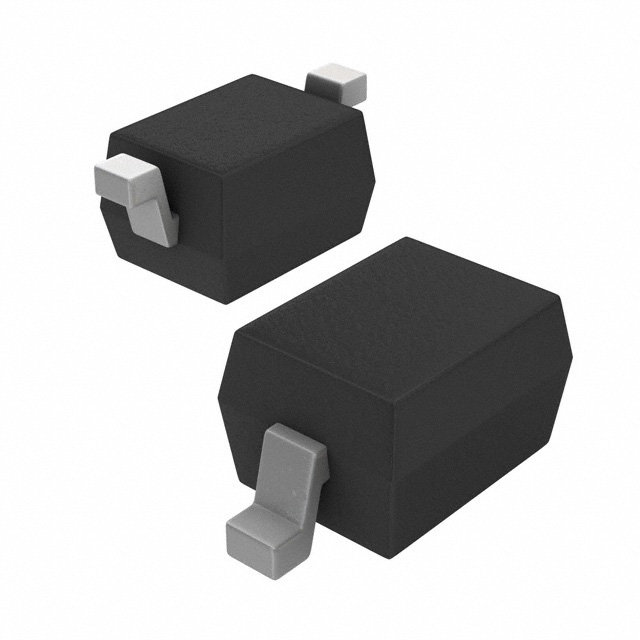BZX384C68-HE3-18
Introduction
The BZX384C68-HE3-18 is a voltage regulator diode that belongs to the category of electronic components. It is commonly used in various electronic circuits for voltage regulation and protection purposes. This entry provides an overview of the basic information, specifications, pin configuration, functional features, advantages and disadvantages, working principles, application field plans, and alternative models of the BZX384C68-HE3-18.
Basic Information Overview
- Category: Electronic Components
- Use: Voltage Regulation and Protection
- Characteristics: Low Leakage Current, High Stability, Reverse Voltage Protection
- Package: SOD-323
- Essence: Voltage Regulator Diode
- Packaging/Quantity: Tape & Reel, 3000 per reel
Specifications
- Voltage Rating: 68V
- Power Dissipation: 250mW
- Forward Voltage Drop: 1V
- Reverse Leakage Current: 5μA
- Operating Temperature Range: -55°C to +150°C
Detailed Pin Configuration
The BZX384C68-HE3-18 has a standard SOD-323 package with two pins. The pinout configuration is as follows: - Pin 1: Anode - Pin 2: Cathode
Functional Features
- Voltage Regulation: Provides stable output voltage under varying input conditions.
- Overvoltage Protection: Safeguards connected circuits from excessive voltage spikes.
- Low Leakage Current: Minimizes power loss and enhances efficiency.
Advantages and Disadvantages
Advantages
- Precise Voltage Regulation
- Compact Size
- Low Power Dissipation
Disadvantages
- Limited Current Handling Capacity
- Sensitivity to Temperature Variations
Working Principles
The BZX384C68-HE3-18 operates based on the principle of Zener breakdown. When the voltage across its terminals exceeds the specified value, it conducts current to regulate the voltage and protect the circuit from overvoltage conditions.
Detailed Application Field Plans
The BZX384C68-HE3-18 finds extensive use in the following applications: - Voltage Regulation in Power Supplies - Overvoltage Protection in Communication Systems - Signal Clipping in Audio Circuits
Detailed and Complete Alternative Models
Some alternative models to the BZX384C68-HE3-18 include: - BZX384C56-HE3-18 - BZX384C75-HE3-18 - BZX384C82-HE3-18 - BZX384C91-HE3-18
In summary, the BZX384C68-HE3-18 is a crucial component in electronic circuits, providing precise voltage regulation and overvoltage protection. Its compact size and stable performance make it suitable for a wide range of applications in various industries.
Word Count: 410
Lista 10 Vanliga frågor och svar relaterade till tillämpningen av BZX384C68-HE3-18 i tekniska lösningar
What is the BZX384C68-HE3-18?
- The BZX384C68-HE3-18 is a Zener diode with a voltage rating of 68V and a power rating of 300mW.
What are the typical applications of BZX384C68-HE3-18?
- It is commonly used in voltage regulation, overvoltage protection, and voltage reference circuits.
What is the maximum current that BZX384C68-HE3-18 can handle?
- The maximum current for BZX384C68-HE3-18 is typically around 20mA.
How does BZX384C68-HE3-18 provide overvoltage protection?
- When the voltage across the diode exceeds its breakdown voltage (68V), it conducts heavily, limiting the voltage to the breakdown level.
What are the temperature specifications for BZX384C68-HE3-18?
- The operating temperature range for BZX384C68-HE3-18 is usually between -65°C to +150°C.
Can BZX384C68-HE3-18 be used in reverse bias?
- Yes, it can be used in reverse bias as a voltage reference or as a protection device against overvoltage conditions.
What is the package type for BZX384C68-HE3-18?
- BZX384C68-HE3-18 is typically available in a SOD-323 surface mount package.
Is BZX384C68-HE3-18 suitable for high-frequency applications?
- No, it is not recommended for high-frequency applications due to its inherent capacitance and response time.
What are the key parameters to consider when designing with BZX384C68-HE3-18?
- Key parameters include breakdown voltage, power dissipation, temperature coefficient, and reverse leakage current.
Are there any alternative components to BZX384C68-HE3-18 with similar specifications?
- Yes, other manufacturers offer similar Zener diodes with comparable voltage ratings and power dissipation capabilities, such as the 1N5221B or the MMBZ5242B.


